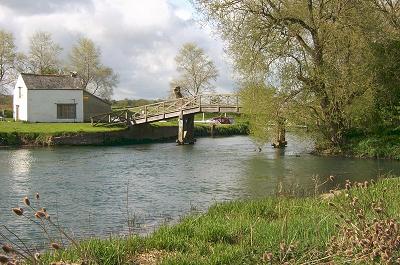Eaton Weir
 Eaton Weir
Eaton Weir
Onwards to Eaton Weir which boasts a pretty rustic bridge but no weir. This was the site of the last of the old “flash weirs” of the Thames and was removed in 1936.
The lock system that we have today is something that is generally taken for granted, but how did they develop?
It is believed that the first dams across the rivers in Britain were made by the Vikings, who during their raids overcame the problems of shallow water stranding their boats by building dams to raise the water level.
A more peaceful use was to provide millers with a sufficient head of water to drive their wheels. Fishermen too made use of artificial weirs to set traps across the river that gave them increased catches. Both of these helped to keep the water deep enough for boats, but there was one major problem. It may have made it easier to move the boats through the deeper waters, but when the craft reached the next weir it came to a sudden stop. There was no way through.
Someone, somewhere, must have been the first to come up with the bright idea that what was needed was a removable section of the dam wall. Take the section away, pass the boat through, put the section back again and away you go. Such must have been the thought process that gave us the “flash lock”.
The early lock gate was a paddle of boards that were pressed by the current of the water against upright boards known as “rymers”. When a boat wanted to travel downstream the paddles would be removed and a flash of water would take the vessel over the weir in the style of shooting the rapids. When the torrent had died down any boat wanting to travel upstream would be hauled up through the gap by either a team of horses or gang of men. Some of the bigger locks used a capstan to ease their toils.
This was not an easy operation to undertake. It was hazardous to say the least, and to perform the manoeuvres successfully required great experience, skill and strength. The removal of the paddles in a speedy manner without also removing ones fingers was not always achieved. Boats shooting the weir must have been a spectacular sight and the adrenaline would have been really pumping through the veins of those whose task it was to steer the vessel down to calmer waters.
Timing was everything. Removing the paddles too slowly would result in the water levels dropping too soon with the boat being grounded in the upstream section, and no doubt strong words were exchanged on such occasions.
< Previous Page | Next Page >